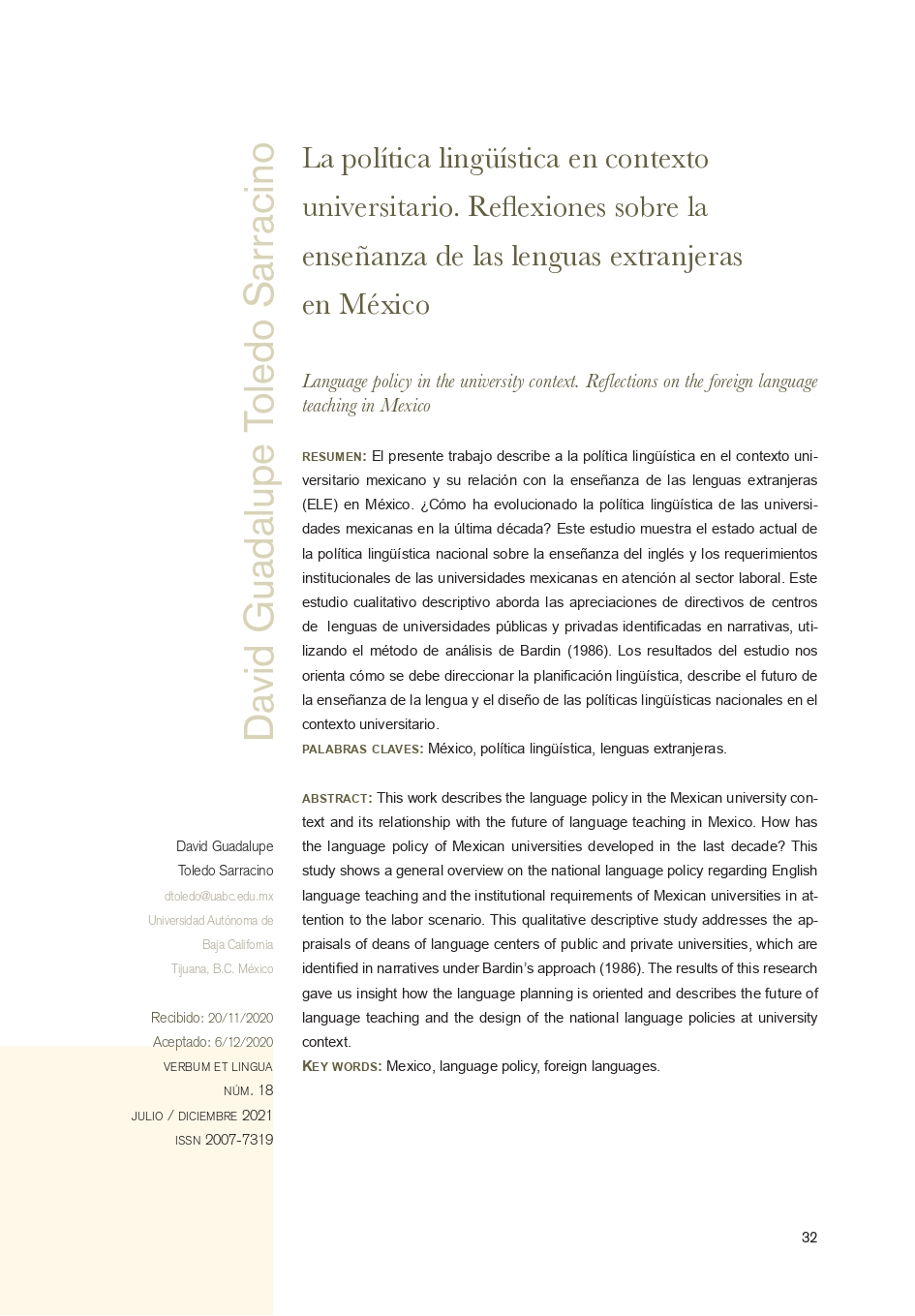La política lingüística en contexto universitario. Reflexiones sobre la enseñanza de las lenguas extranjeras en México.
DOI:
https://doi.org/10.32870/vel.vi18.158Abstract
El presente trabajo describe a la política lingüística en el contexto universitario mexicano y su relación con la enseñanza de las lenguas extranjeras (ELE) en México. ¿Cómo ha evolucionado la política lingüística de las universidades mexicanas en la última década? Este estudio muestra el estado actual de la política lingüística nacional sobre la enseñanza del inglés y los requerimientos institucionales de las universidades mexicanas en atención al sector laboral. Este estudio cualitativo descriptivo aborda las apreciaciones de directivos de centros de lenguas de universidades públicas y privadas identificadas en narrativas, utilizando el método de análisis de Bardin (1986). Los resultados del estudio nos orienta cómo se debe direccionar la planificación lingüística, describe el futuro de la enseñanza de la lengua y el diseño de las políticas lingüísticas nacionales en el contexto universitario.
Downloads
Metriche
Riferimenti bibliografici
Arnaéz, P. (2006). La lingüística aplicada a la enseñanza de la lengua: una línea de investigación. Revista Letras, XLVIII. 48:349-363.
Arnoux, E. y Bein, R. (eds.) (2015). Política Lingüísticas y Enseñanza de Lenguas. Buenos Aires, Argentina: Editorial Biblos.
ANUIES (09 de octubre de 2020). Portal ANUIES. Ciudad de México. Directorio de IES afiliadas.http://www.anuies.mx/anuies/estructura- organica/consejo-de-universidades-publicas-e-instituciones-afines- cupia/directorio-de-ies-afiliadas
Bardin, L. (1986). El análisis de contenido. Madrid:Akal.
Cobarrubias, J. y J. A. Fishman (1983). Progress in language planning: international perspectives. Sociology in Language. 31:1:vi-383.
Cooper, R. L. (1997). La planificación lingüística y el cambio social. Cambridge:
C. U. P.
El Universal (19 de diciembre de 2020). Diputados aprueban reconocer a lenguas indígenas y al español como idiomas nacionales. Recuperado de https://www.eluniversal.com.mx/nacion/diputados-aprueban- reconocer-lenguas-indigenas-y-al-espanol-como-idiomas-nacionales
Moreno, T. (20 de junio de 2019). Inglés. Enseñanza imposible por falta de maestros en la SEP. Recuperado de: http://www.eluniversal.com.mx/articulo/nacion/sociedad/2016/08/17/ingles- ensenanza-imposible-por-falta-de-maestros-en-sep
Roseti, l. y de Francesco, K. (2017). Inglés: La lengua extranjera por antonomasia. Revista Digital de Políticas Lingüística. 9:1-13.
Toledo, D.G. Montaño, S., López, I. y Martínez, E. (2018). La política lingüística y formación del profesor en Baja California. Una mirada desde la universidad. En Toledo, D.G., Socorro, S. y Villalobos, L. (Coords.) (2018). Política Lingüística y Enseñanza de Lenguas Extranjeras en las IES en México (pp.85-113). Mexicali, México:UABC.
Toledo, D.G. y García-Landa, L. (2018). Escenarios lingüísticos emergentes en la frontera Tijuana-San Diego. Káñina, Rev. Artes y Letras, Universidad de Costa Rica.2:1-25.
Toledo, D.G., Montaño, M.S., Villalobos, L. (2018). Política lingüística y enseñanza de lenguas extranjeras en las Instituciones de Educación Superior en México. Mexicali, México:UABC

Downloads
Pubblicato
Versioni
- 2024-11-08 (2)
- 2022-06-21 (1)












